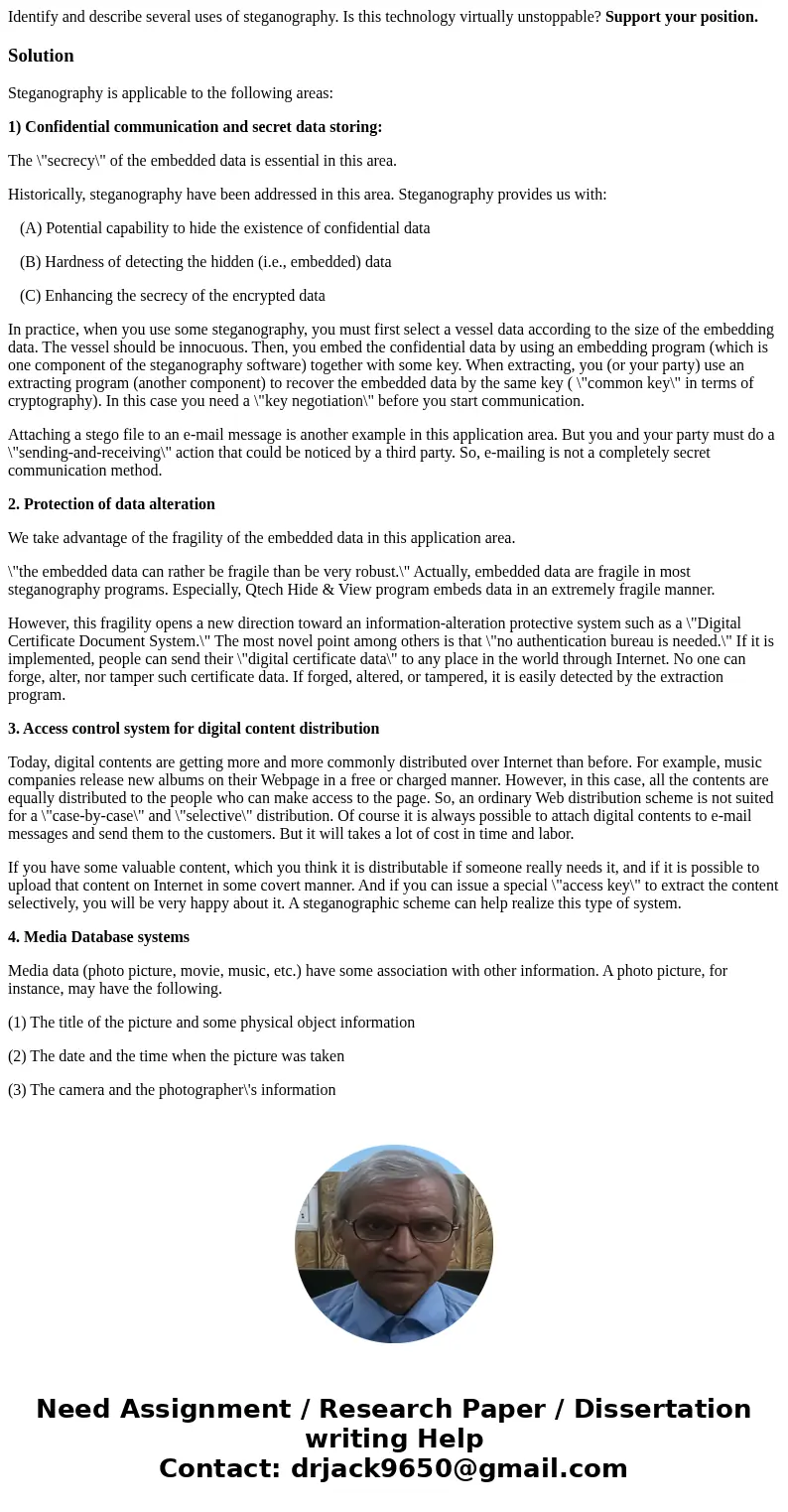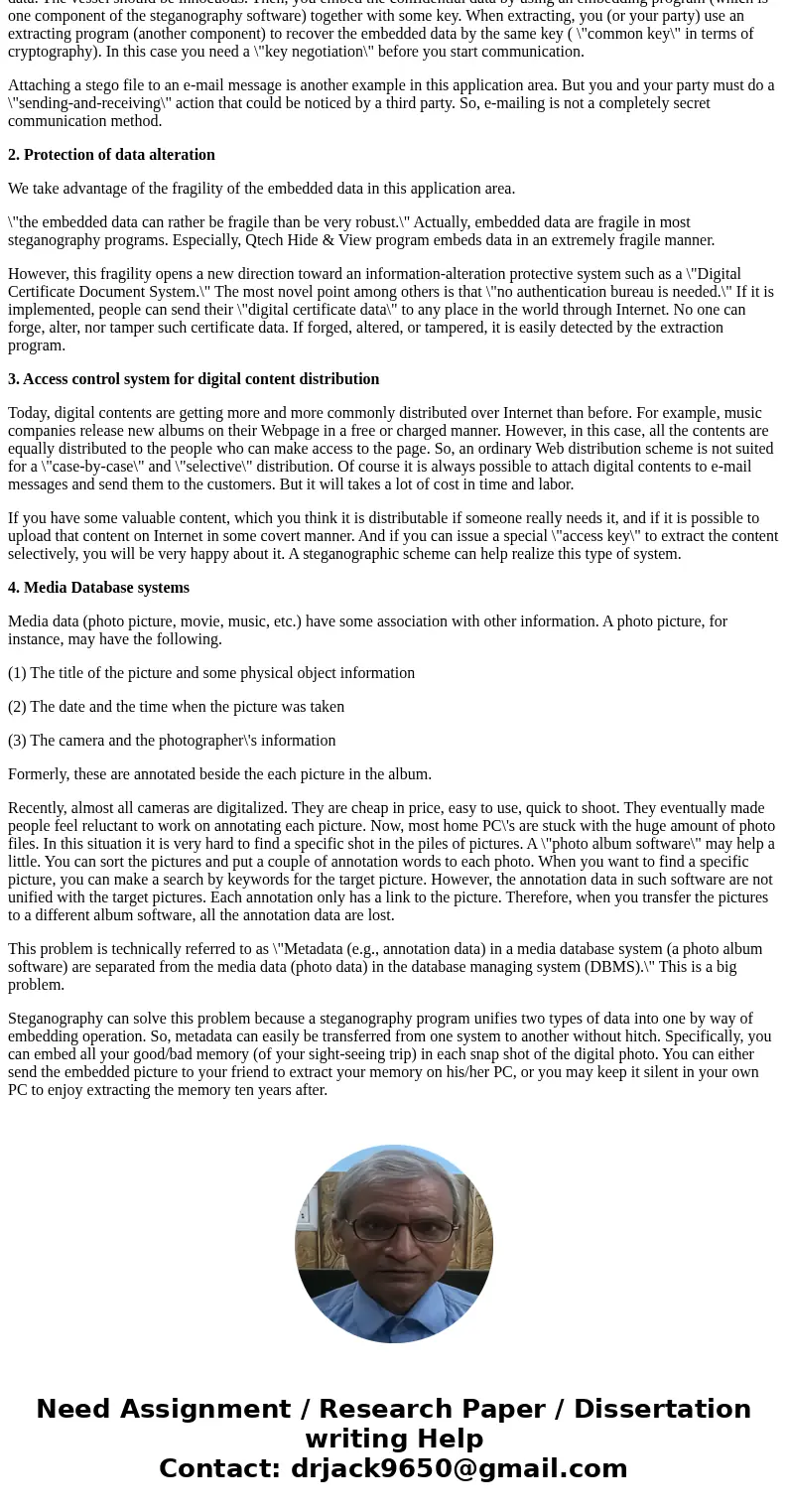Identify and describe several uses of steganography Is this
Identify and describe several uses of steganography. Is this technology virtually unstoppable? Support your position.
Solution
Steganography is applicable to the following areas:
1) Confidential communication and secret data storing:
The \"secrecy\" of the embedded data is essential in this area.
Historically, steganography have been addressed in this area. Steganography provides us with:
(A) Potential capability to hide the existence of confidential data
(B) Hardness of detecting the hidden (i.e., embedded) data
(C) Enhancing the secrecy of the encrypted data
In practice, when you use some steganography, you must first select a vessel data according to the size of the embedding data. The vessel should be innocuous. Then, you embed the confidential data by using an embedding program (which is one component of the steganography software) together with some key. When extracting, you (or your party) use an extracting program (another component) to recover the embedded data by the same key ( \"common key\" in terms of cryptography). In this case you need a \"key negotiation\" before you start communication.
Attaching a stego file to an e-mail message is another example in this application area. But you and your party must do a \"sending-and-receiving\" action that could be noticed by a third party. So, e-mailing is not a completely secret communication method.
2. Protection of data alteration
We take advantage of the fragility of the embedded data in this application area.
\"the embedded data can rather be fragile than be very robust.\" Actually, embedded data are fragile in most steganography programs. Especially, Qtech Hide & View program embeds data in an extremely fragile manner.
However, this fragility opens a new direction toward an information-alteration protective system such as a \"Digital Certificate Document System.\" The most novel point among others is that \"no authentication bureau is needed.\" If it is implemented, people can send their \"digital certificate data\" to any place in the world through Internet. No one can forge, alter, nor tamper such certificate data. If forged, altered, or tampered, it is easily detected by the extraction program.
3. Access control system for digital content distribution
Today, digital contents are getting more and more commonly distributed over Internet than before. For example, music companies release new albums on their Webpage in a free or charged manner. However, in this case, all the contents are equally distributed to the people who can make access to the page. So, an ordinary Web distribution scheme is not suited for a \"case-by-case\" and \"selective\" distribution. Of course it is always possible to attach digital contents to e-mail messages and send them to the customers. But it will takes a lot of cost in time and labor.
If you have some valuable content, which you think it is distributable if someone really needs it, and if it is possible to upload that content on Internet in some covert manner. And if you can issue a special \"access key\" to extract the content selectively, you will be very happy about it. A steganographic scheme can help realize this type of system.
4. Media Database systems
Media data (photo picture, movie, music, etc.) have some association with other information. A photo picture, for instance, may have the following.
(1) The title of the picture and some physical object information
(2) The date and the time when the picture was taken
(3) The camera and the photographer\'s information
Formerly, these are annotated beside the each picture in the album.
Recently, almost all cameras are digitalized. They are cheap in price, easy to use, quick to shoot. They eventually made people feel reluctant to work on annotating each picture. Now, most home PC\'s are stuck with the huge amount of photo files. In this situation it is very hard to find a specific shot in the piles of pictures. A \"photo album software\" may help a little. You can sort the pictures and put a couple of annotation words to each photo. When you want to find a specific picture, you can make a search by keywords for the target picture. However, the annotation data in such software are not unified with the target pictures. Each annotation only has a link to the picture. Therefore, when you transfer the pictures to a different album software, all the annotation data are lost.
This problem is technically referred to as \"Metadata (e.g., annotation data) in a media database system (a photo album software) are separated from the media data (photo data) in the database managing system (DBMS).\" This is a big problem.
Steganography can solve this problem because a steganography program unifies two types of data into one by way of embedding operation. So, metadata can easily be transferred from one system to another without hitch. Specifically, you can embed all your good/bad memory (of your sight-seeing trip) in each snap shot of the digital photo. You can either send the embedded picture to your friend to extract your memory on his/her PC, or you may keep it silent in your own PC to enjoy extracting the memory ten years after.


 Homework Sourse
Homework Sourse